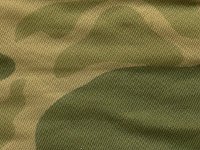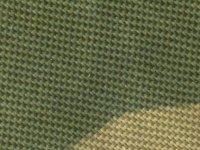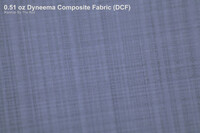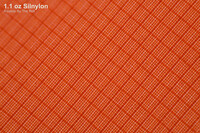2. Analysis of tissues
2.1 Appearance
Preliminarily inspection of the fabric:
- Size of the
square ripstop
(axb) mm. We must measure the length of 10 or more squares and divide
by the distance in both directions, longitudinal (warp) and transverse
(weft).
- Single or
double ripstop. See if the fabric of yarn is formed by one or two
threads.
- Touch soft or
rough
- Noise crunchy
or no, rubbing the fabric
- Fabric color
- Coating in one or both sides. The brighter side is usually carrying
the coated. The usual coating is generally based on polyurethane or
silicone.
2.2
Analysis with optical microscope (or scanner)
Next Laboratori purchase: an optical
microscope. The microscope will allow to observe and count the
individual threads
within each square of rip, and in both directions. It also lets us
check and "see" the porosity of the fabric, and regularity of crossing threads.
2.3 Weight
The tissue should be measured by weighing a substantial amount of
tissue divided by its surface. We get the weight in g/m2. The standard
weights are:
27 g/m2 hyper lightweight tissues
36-40 g/m2 lightweight tissues
45 g/m2 normal tissues
52 g/m2 heavy tissues
2.4
Porosity test
Is described in this
chapter of the laboratory.
2.5 Tear
resistance (Bettsometer)
The Bettsometer is a curved needle attached to a dynamometer. Involves
pricking the tissue and pull up slightly to get tear in the ripstop.
The resultant force (kg) is the result of the experiment. Indicates the
overall status of the tissue, compared with the force required to tear
a new one.
2.6 Force
versus displacement analysis
One of the most
interesting experiments to perform, with a piece of
ripstop, is the progressive loading of a tape 5 cm wide, measuring the
deformation and the load simultaneous, to fracture (20 kg - 30 kg) in
experiments conducted so far .
This experiment is described here.
3. Where
to find ripstop fabric
Metropolis
Drachen
http://www.metropolis-drachen.de/cgi-bin/iboshop.cgi?show280,394509232923176
Cerf volant
service (France):
https://www.cerfvolantservice.com/contents/fr/d56.html
Spinnaker CX2
polyester 42 gr
La Vieille Usine
(France)
http://www.vieilleusine.com/
Economat
(Belgique)
http://lencb.be/economat_spi.php
Chikara
Shelby (Finland)
http://www.shelby.fi/catalog/default.php
http://www.shelby.fi/catalog/default.php?cPath=22
Kitebuilder.com
(USA)
http://www.kitebuilder.com/catalog/index.php/cPath/24_108_230?osCsid=c3de0b63695e7a1c39c4ef5d3b2eaa6c
El Ventilador
(Barcelona)
http://www.ventilador.com/Productos.asp?IdCategoria=5&IdSubCategoria=54&vCat=5
Ripstop Eolo
42gr y 60gr
Manufacturers:
Gelvenor Textiles http://www.gelvenor.com/ (Durban, South
Africa)
Porcher Sport http://www.porcher-ind.com/ (France)
Dominico (Korea)
Chikara
Terraza
(Barcelona)
http://www.productpilot.com/alis.php?zoom=6FyHfL2J%2BfFxQxcmu2YLFw%3D%3D
http://www.terraza-sl.com
4. Hang glider sails
The big brands
WW, Moyes.., use Dacron 170 g/m2 as basic option.
Finsterwalder
Perfex use Dacron 110 g/m2, and optional 160 gr/m2
Thomas
Finsterwalder flight from Kilimanjaro (1976) was performed with a
Bergfex and
spinnacker
nylon fabric with 32 g/m2...
Polyester=Dacron=Terylene
Wills Wing article
http://www.willswing.com/features/sailcloth.asp
http://www.willswing.com/Articles/Article.asp?reqArticleName=Sailcloth
http://www.willswing.com/Articles/Article.asp?reqArticleName=Sailcloth#
Dimension
Polyant:
http://www.dimension-polyant.com/en/Sailcloth_Technology_2.php
Bainbridge:
http://www.marine-covers.com/searchCatalogue.asp?id=311
Units:
1oz=28.35 g
1 lb=453.6 g
=16oz
1 yard = 0.9144 m





































